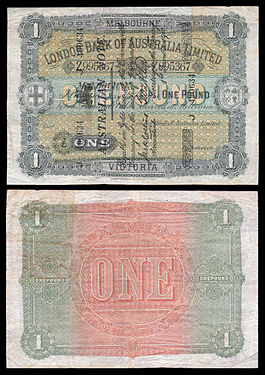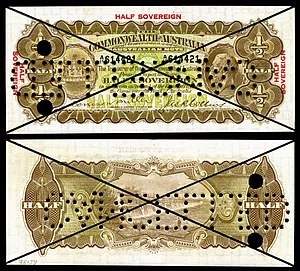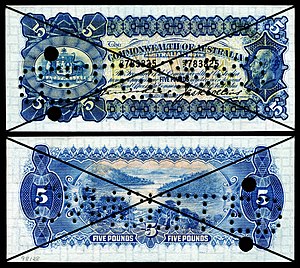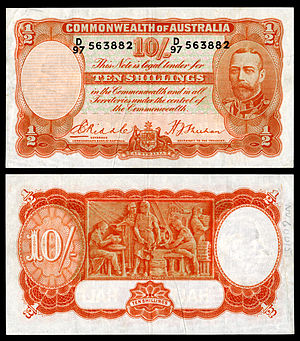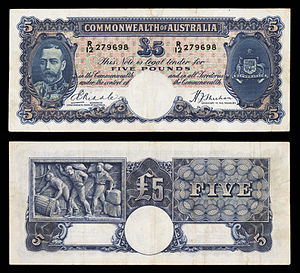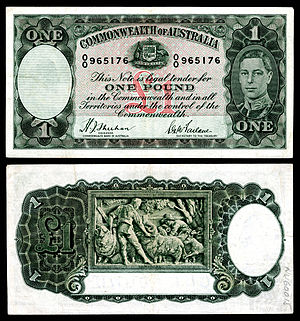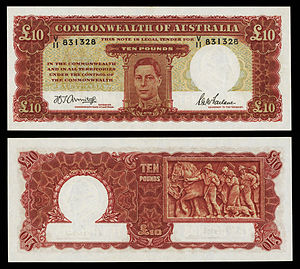Banknotes of the Australian pound: Difference between revisions
m removing stale inuse template as last edited 1 days ago |
m comment out unused converts to avoid error; dashes |
||
| Line 1: | Line 1: | ||
{{Css Image Crop|Image = AUS-Bank of Queensland Limited Dalby Branch £1 Dec 1, 1864.jpg|bSize = 265|cWidth = 265|cHeight = 166|oTop = 0|oLeft = 0|Location = right|Description=An issued Bank of Queensland £1 note (1864)}} |
{{Css Image Crop|Image = AUS-Bank of Queensland Limited Dalby Branch £1 Dec 1, 1864.jpg|bSize = 265|cWidth = 265|cHeight = 166|oTop = 0|oLeft = 0|Location = right|Description=An issued Bank of Queensland £1 note (1864)}} |
||
'''Banknotes of the Australian pound''' were first issued by numerous private banks in Australia, starting with the [[Bank of New South Wales]] in 1817.{{sfn|Pitt|2013|p=163}}{{refn| This article is a split-off from [[Australian pound]]. The opening text was initially copied verbatim from the [[Australian_pound#Banknotes|Banknotes]] section of the article.| group="nb"}} Acceptance of private bank notes was not made compulsory by [[legal tender]] laws but they were widely used and accepted. The [[Queensland]] government issued treasury notes ( |
'''Banknotes of the Australian pound''' were first issued by numerous private banks in Australia, starting with the [[Bank of New South Wales]] in 1817.{{sfn|Pitt|2013|p=163}}{{refn| This article is a split-off from [[Australian pound]]. The opening text was initially copied verbatim from the [[Australian_pound#Banknotes|Banknotes]] section of the article.| group="nb"}} Acceptance of private bank notes was not made compulsory by [[legal tender]] laws but they were widely used and accepted. The [[Queensland]] government issued treasury notes (1866–1869) and banknotes (1893–1910){{sfn|Pitt|2013|p=180}} which were [[legal tender]] ''in'' Queensland. The [[New South Wales]] government issued a limited series of Treasury Notes in 1893.{{sfn|Pitt|2013|p=180}} |
||
In 1910, the Commonwealth passed the ''Australian Notes Act of 1910'' to initiate banking and currency reform. The Act stipulated that six months after the date of passage (16 September 1910), private banks could no longer issue any form of money, and that any note or instrument issued by a State Bank would no longer be considered legal tender.{{sfn|Australian Notes Act|1910|p=14}} The Act further established the powers of the Commonwealth to issue, re-issue, and cancel Australian notes.{{sfn|Australian Notes Act|1910|p=15}} The Act also established denominations, legal tender status, and the amount of gold coin held in reserve to secure the issues.{{sfn|Australian Notes Act|1910|p=15}} On 10 October 1910 (prior to the effective date of the Notes Act), a [[Bank Notes Tax Act 1910]] imposed a "Ten pounds per centum" tax on all issued or re-issued bank notes.{{sfn|Bank Notes Tax Act|1910}} A third currency reform act was passed on 22 December 1911 establishing the Commonwealth Bank.{{sfn|Commonwealth Bank Act|1911}} The Commonwealth Bank Act of 1911 specifically stated that the Bank was not to issue bills or notes for circulation.{{sfn|Commonwealth Bank Act|1911|p=Part II(8)}} The Australian Treasury issued banknotes until a 1920 amendment to the Commonwealth Bank Act of 1911. The amendment established a note-issuing department within the bank which assumed the responsibilities previously held by the Treasury.{{sfn|Commonwealth Bank Act|1920|p=No.7(60a-60h)}} |
In 1910, the Commonwealth passed the ''Australian Notes Act of 1910'' to initiate banking and currency reform. The Act stipulated that six months after the date of passage (16 September 1910), private banks could no longer issue any form of money, and that any note or instrument issued by a State Bank would no longer be considered legal tender.{{sfn|Australian Notes Act|1910|p=14}} The Act further established the powers of the Commonwealth to issue, re-issue, and cancel Australian notes.{{sfn|Australian Notes Act|1910|p=15}} The Act also established denominations, legal tender status, and the amount of gold coin held in reserve to secure the issues.{{sfn|Australian Notes Act|1910|p=15}} On 10 October 1910 (prior to the effective date of the Notes Act), a [[Bank Notes Tax Act 1910]] imposed a "Ten pounds per centum" tax on all issued or re-issued bank notes.{{sfn|Bank Notes Tax Act|1910}} A third currency reform act was passed on 22 December 1911 establishing the Commonwealth Bank.{{sfn|Commonwealth Bank Act|1911}} The Commonwealth Bank Act of 1911 specifically stated that the Bank was not to issue bills or notes for circulation.{{sfn|Commonwealth Bank Act|1911|p=Part II(8)}} The Australian Treasury issued banknotes until a 1920 amendment to the Commonwealth Bank Act of 1911. The amendment established a note-issuing department within the bank which assumed the responsibilities previously held by the Treasury.{{sfn|Commonwealth Bank Act|1920|p=No.7(60a-60h)}} |
||
{{clear}} |
{{clear}} |
||
==Superscribed banknotes ( |
==Superscribed banknotes (1910–1914)== |
||
{{Css Image Crop|Image = AUS-S45-London Bank of Australia Limited-One Pound (1910-14, superscribed).jpg|bSize = 265|cWidth = 265|cHeight = 190|oTop = 0|oLeft = 0|Location = right|Description=A superscribed note from the London Bank of Australia Limited}} |
{{Css Image Crop|Image = AUS-S45-London Bank of Australia Limited-One Pound (1910-14, superscribed).jpg|bSize = 265|cWidth = 265|cHeight = 190|oTop = 0|oLeft = 0|Location = right|Description=A superscribed note from the London Bank of Australia Limited}} |
||
The first national issue of paper money (known as Superscribed banknotes) consisted of overprinted notes from fifteen private banks and the Queensland government, issued between |
The first national issue of paper money (known as Superscribed banknotes) consisted of overprinted notes from fifteen private banks and the Queensland government, issued between 1910–1914 in denominations of £1, £5, £10, £20, £50 and £100.{{sfn|Pitt|2013|p=176}} The notes, purchased by the Australian government from the remaining private bank stock,{{sfn|Pitt|2013|p=176}} were overprinted with the words "Australian note". Surviving notes above the £10 denomination are extremely rare: two £20 notes are known (privately held), £50 notes are known in the collections of the [[Reserve Bank of Australia]] and the [[Art Gallery of South Australia]], and no £100 banknotes of this series are known to exist.{{sfn|Pitt|2013|p=176}} |
||
{{clear}} |
{{clear}} |
||
{| class="wikitable" |
{| class="wikitable" |
||
| Line 134: | Line 134: | ||
In 1913 the first national [[banknotes]] were introduced in denominations of 10s,{{sfn|Pitt|2013|p=183}} £1,{{sfn|Pitt|2013|p=191}} £5,{{sfn|Pitt|2013|p=200}} and £10.{{sfn|Pitt|2013|p=207}} 1914 saw the introduction of £20,{{sfn|Pitt|2013|p=212}} £50,{{sfn|Pitt|2013|p=213}} £100,{{sfn|Pitt|2013|p=214}} and £1000 notes.{{sfn|Pitt|2013|p=215}} The £1000 note only saw limited circulation and was later confined to inter-bank use. Stocks were destroyed in 1969 and there are no uncancelled examples of this note known to exist in private hands, though a single cancelled example sold in a 2007 auction for AU$1,200,000.{{sfn|Pitt|2013|p=215}} |
In 1913 the first national [[banknotes]] were introduced in denominations of 10s,{{sfn|Pitt|2013|p=183}} £1,{{sfn|Pitt|2013|p=191}} £5,{{sfn|Pitt|2013|p=200}} and £10.{{sfn|Pitt|2013|p=207}} 1914 saw the introduction of £20,{{sfn|Pitt|2013|p=212}} £50,{{sfn|Pitt|2013|p=213}} £100,{{sfn|Pitt|2013|p=214}} and £1000 notes.{{sfn|Pitt|2013|p=215}} The £1000 note only saw limited circulation and was later confined to inter-bank use. Stocks were destroyed in 1969 and there are no uncancelled examples of this note known to exist in private hands, though a single cancelled example sold in a 2007 auction for AU$1,200,000.{{sfn|Pitt|2013|p=215}} |
||
Design alterations were introduced fairly quickly. Beginning in 1915, 10s notes included a red "Half Sovereign" overprint.{{sfn|Pitt|2013|p=184}} Banknote size was reduced for the £1 (1923),{{sfn|Pitt|2013|p=195}} £5 (1924),{{sfn|Pitt|2013|p=202}} and £10 (1925).{{sfn|Pitt|2013|p=208}} A portrait of [[George V of the United Kingdom|King George V]] was introduced in the mid 1920s on the 10s through £10 notes.{{sfn|Pitt|2013|pp= |
Design alterations were introduced fairly quickly. Beginning in 1915, 10s notes included a red "Half Sovereign" overprint.{{sfn|Pitt|2013|p=184}} Banknote size was reduced for the £1 (1923),{{sfn|Pitt|2013|p=195}} £5 (1924),{{sfn|Pitt|2013|p=202}} and £10 (1925).{{sfn|Pitt|2013|p=208}} A portrait of [[George V of the United Kingdom|King George V]] was introduced in the mid 1920s on the 10s through £10 notes.{{sfn|Pitt|2013|pp=185–208}} These notes still referred to the currency's convertibility to gold on demand.{{sfn|Pitt|2013|pp=185–208}} A newer £1000 note (1923–1928) with the profile of George V was also prepared but never issued.{{sfn|Pitt|2013|p=220}} A punch-cancelled specimen note was discovered in [[London]] in 1996 and subsequently sold for a sum in excess of $200,000. Nonetheless, this note is not recognized as a legitimate Australian banknote issue. |
||
Just after the start of the [[Great Depression]] in 1933, Australian currency ceased to be redeemable for gold at the previously maintained rate of one gold sovereign for one pound currency. Subsequently a new series of [[Legal Tender]] notes were designed, once again bearing the portrait of King George V, in denominations of 10s, £1, £5 and £10.{{sfn|Pitt|2013|pp= |
Just after the start of the [[Great Depression]] in 1933, Australian currency ceased to be redeemable for gold at the previously maintained rate of one gold sovereign for one pound currency. Subsequently a new series of [[Legal Tender]] notes were designed, once again bearing the portrait of King George V, in denominations of 10s, £1, £5 and £10.{{sfn|Pitt|2013|pp=185–209}} These denominations and designs were maintained and modified to accommodate the portrait of [[George VI of the United Kingdom|King George VI]] in 1938.{{sfn|Pitt|2013|pp=189–210}} For both issues £50 and £100 specimens were prepared, but were not issued.{{sfn|Pitt|2013|pp=219–220}} |
||
===Issuance of the Australian pound banknote ( |
===Issuance of the Australian pound banknote (1913–1965)=== |
||
{| class="wikitable sortable" |
{| class="wikitable sortable" |
||
|+ Issuance of the Australian pound banknote ( |
|+ Issuance of the Australian pound banknote (1913–1965) |
||
|- |
|- |
||
! scope="col" style="width:40px;"| Issue{{sfn|Cuhaj|2010}} |
! scope="col" style="width:40px;"| Issue{{sfn|Cuhaj|2010}} |
||
| Line 183: | Line 183: | ||
!<span style="display:none">1000.00-1914</span>1,000 Pounds<br>1914–24 |
!<span style="display:none">1000.00-1914</span>1,000 Pounds<br>1914–24 |
||
|{{Css Image Crop|Image = AUS-2A-Commonwealth of Australia-1000 Pounds ( |
|{{Css Image Crop|Image = AUS-2A-Commonwealth of Australia-1000 Pounds (1914–24).jpg|bSize = 300|cWidth = 300|cHeight = 194|oTop = 5|oLeft = 0|Location = center}} |
||
| [[James Collins (public servant)|Collins]] and [[George Allen (public servant)|Allen]]<br>Kell and Collins (1925) |
| [[James Collins (public servant)|Collins]] and [[George Allen (public servant)|Allen]]<br>Kell and Collins (1925) |
||
|[[Obverse and reverse|O]]:[[Coat of arms of Australia|Arms]]<br>[[Obverse and reverse|R]]:[[Merino|Merino sheep]] in [[Bungaree, South Australia|Bungaree]]<br>{{convert|215x143|mm|in|abbr=on}} |
|[[Obverse and reverse|O]]:[[Coat of arms of Australia|Arms]]<br>[[Obverse and reverse|R]]:[[Merino|Merino sheep]] in [[Bungaree, South Australia|Bungaree]]<br>{{convert|215x143|mm|in|abbr=on}} |
||
| Line 331: | Line 331: | ||
| |
| |
||
|[http://adb.anu.edu.au/biography/armitage-hugh-traill-9382 Armitage] and [[Stuart McFarlane|McFarlane]]<br>(not Issued) |
|[http://adb.anu.edu.au/biography/armitage-hugh-traill-9382 Armitage] and [[Stuart McFarlane|McFarlane]]<br>(not Issued) |
||
|[[Obverse and reverse|O]]:[[George VI]], black with red-brown underprint<br>[[Obverse and reverse|R]]:Australian crown coin<br>{{convert|x|mm|in|abbr=on}} |
|[[Obverse and reverse|O]]:[[George VI]], black with red-brown underprint<br>[[Obverse and reverse|R]]:Australian crown coin<br><!--{{convert|x|mm|in|abbr=on}}--> |
||
|- |
|- |
||
| Line 361: | Line 361: | ||
| |
| |
||
| [[Harry Sheehan|Sheehan]] and [[Stuart McFarlane|McFarlane]]<br>specimen only, not issued |
| [[Harry Sheehan|Sheehan]] and [[Stuart McFarlane|McFarlane]]<br>specimen only, not issued |
||
|[[Obverse and reverse|O]]:[[George VI]], purple with multicolor underprint<br>[[Watermark|WM]]:Captain [[James Cook]]<br>{{convert|x|mm|in|abbr=on}} |
|[[Obverse and reverse|O]]:[[George VI]], purple with multicolor underprint<br>[[Watermark|WM]]:Captain [[James Cook]]<br><!--{{convert|x|mm|in|abbr=on}}--> |
||
|- |
|- |
||
| Line 367: | Line 367: | ||
| |
| |
||
| [[Harry Sheehan|Sheehan]] and [[Stuart McFarlane|McFarlane]] <br>specimen only, not issued |
| [[Harry Sheehan|Sheehan]] and [[Stuart McFarlane|McFarlane]] <br>specimen only, not issued |
||
|[[Obverse and reverse|O]]:[[George VI]], brown with multicolor underprint<br>[[Watermark|WM]]:Captain [[James Cook]] (suspected)<br>{{convert|x|mm|in|abbr=on}} |
|[[Obverse and reverse|O]]:[[George VI]], brown with multicolor underprint<br>[[Watermark|WM]]:Captain [[James Cook]] (suspected)<br><!--{{convert|x|mm|in|abbr=on}}--> |
||
|- |
|- |
||
| Line 373: | Line 373: | ||
!<span style="display:none">0000.50-1954</span>[[Australian ten-shilling note|10 Shillings]]<br>1954–66 |
!<span style="display:none">0000.50-1954</span>[[Australian ten-shilling note|10 Shillings]]<br>1954–66 |
||
|{{Css Image Crop|Image = AUS-29-Commonwealth Bank of Australia-10 Shillings ( |
|{{Css Image Crop|Image = AUS-29-Commonwealth Bank of Australia-10 Shillings (1954–60).jpg|bSize = 300|cWidth = 300|cHeight = 173|oTop = 0|oLeft = 0|Location = center}} |
||
|[[H.C. Coombs|Coombs]] and [[Roland Wilson (economist)|Wilson]] (1954)<br>Coombs and Wilson (1961) |
|[[H.C. Coombs|Coombs]] and [[Roland Wilson (economist)|Wilson]] (1954)<br>Coombs and Wilson (1961) |
||
|[[Obverse and reverse|O]]:[[Matthew Flinders]], [[Coat of arms of Australia|arms]], brown with multicolor underprint<br>[[Obverse and reverse|R]]:[[Old Parliament House, Canberra |Old Parliament House]]<br>[[Watermark|WM]]:Captain [[James Cook]]<br>{{convert|137x76|mm|in|abbr=on}} |
|[[Obverse and reverse|O]]:[[Matthew Flinders]], [[Coat of arms of Australia|arms]], brown with multicolor underprint<br>[[Obverse and reverse|R]]:[[Old Parliament House, Canberra |Old Parliament House]]<br>[[Watermark|WM]]:Captain [[James Cook]]<br>{{convert|137x76|mm|in|abbr=on}} |
||
| Line 417: | Line 417: | ||
* £5 – Rear Admiral Sir [[John Franklin]] |
* £5 – Rear Admiral Sir [[John Franklin]] |
||
* £10 – Admiral [[Arthur Phillip]] |
* £10 – Admiral [[Arthur Phillip]] |
||
* £50 |
* £50 – Sir [[Henry Parkes]] (This note was never issued to the public. A few specimens exist in bank collections, with one in private hands.{{citation needed|date=August 2012}}) |
||
* £100 |
* £100 – Sir [[Edmund Barton]] (This note was never issued to the public. A few specimens exist in bank collections, with none in private hands.)--> |
||
<!-- In progress, needs work --> |
<!-- In progress, needs work --> |
||
| Line 435: | Line 435: | ||
===Bibliography=== |
===Bibliography=== |
||
*{{Cite book |url=https://books.google.com/books?id=22dKPgAACAAJ&dq=standard+catalog+of+specialized+issues&hl=en&sa=X&ei=HLRiVZD4FcmXygSZj4Fg&ved=0CCgQ6AEwAg|location=|page=|title= Standard Catalog of World Paper Money Specialized Issues|edition=11|ref=harv|publisher=Krause|isbn=978-1-4402-0450-0|editor-last=Cuhaj|editor-first=George S.|year=2009}} |
*{{Cite book |url=https://books.google.com/books?id=22dKPgAACAAJ&dq=standard+catalog+of+specialized+issues&hl=en&sa=X&ei=HLRiVZD4FcmXygSZj4Fg&ved=0CCgQ6AEwAg|location=|page=|title= Standard Catalog of World Paper Money Specialized Issues|edition=11|ref=harv|publisher=Krause|isbn=978-1-4402-0450-0|editor-last=Cuhaj|editor-first=George S.|year=2009}} |
||
*{{Cite book|url= http://books.google.com/books/about/Standard_Catalog_Of_World_Paper_Money_Ge.html?id=BuNA39dnuHsC |location=|page=|title= Standard Catalog of World Paper Money General Issues ( |
*{{Cite book|url= http://books.google.com/books/about/Standard_Catalog_Of_World_Paper_Money_Ge.html?id=BuNA39dnuHsC |location=|page=|title= Standard Catalog of World Paper Money General Issues (1368–1960)|edition=13|ref=harv|publisher=Krause|isbn=978-1-4402-1293-2|editor-last=Cuhaj|editor-first=George S.|year=2010}} |
||
*{{cite book |url= https://books.google.com/books?id=eLjpnQEACAAJ |location= |title= Renniks Australian Coin and Banknote Values|edition=25|ref=harv |publisher= Renniks Publications|isbn=978-0-9873386-2-4|editor-last=Pitt|editor-first=Michael T.||year=2013}} |
*{{cite book |url= https://books.google.com/books?id=eLjpnQEACAAJ |location= |title= Renniks Australian Coin and Banknote Values|edition=25|ref=harv |publisher= Renniks Publications|isbn=978-0-9873386-2-4|editor-last=Pitt|editor-first=Michael T.||year=2013}} |
||
Revision as of 08:05, 7 August 2015
Banknotes of the Australian pound were first issued by numerous private banks in Australia, starting with the Bank of New South Wales in 1817.[1][nb 1] Acceptance of private bank notes was not made compulsory by legal tender laws but they were widely used and accepted. The Queensland government issued treasury notes (1866–1869) and banknotes (1893–1910)[2] which were legal tender in Queensland. The New South Wales government issued a limited series of Treasury Notes in 1893.[2]
In 1910, the Commonwealth passed the Australian Notes Act of 1910 to initiate banking and currency reform. The Act stipulated that six months after the date of passage (16 September 1910), private banks could no longer issue any form of money, and that any note or instrument issued by a State Bank would no longer be considered legal tender.[3] The Act further established the powers of the Commonwealth to issue, re-issue, and cancel Australian notes.[4] The Act also established denominations, legal tender status, and the amount of gold coin held in reserve to secure the issues.[4] On 10 October 1910 (prior to the effective date of the Notes Act), a Bank Notes Tax Act 1910 imposed a "Ten pounds per centum" tax on all issued or re-issued bank notes.[5] A third currency reform act was passed on 22 December 1911 establishing the Commonwealth Bank.[6] The Commonwealth Bank Act of 1911 specifically stated that the Bank was not to issue bills or notes for circulation.[7] The Australian Treasury issued banknotes until a 1920 amendment to the Commonwealth Bank Act of 1911. The amendment established a note-issuing department within the bank which assumed the responsibilities previously held by the Treasury.[8]
Superscribed banknotes (1910–1914)
The first national issue of paper money (known as Superscribed banknotes) consisted of overprinted notes from fifteen private banks and the Queensland government, issued between 1910–1914 in denominations of £1, £5, £10, £20, £50 and £100.[9] The notes, purchased by the Australian government from the remaining private bank stock,[9] were overprinted with the words "Australian note". Surviving notes above the £10 denomination are extremely rare: two £20 notes are known (privately held), £50 notes are known in the collections of the Reserve Bank of Australia and the Art Gallery of South Australia, and no £100 banknotes of this series are known to exist.[9]
| Bank Charter (in operation) |
Location | Branches | Issue | In operation |
|---|---|---|---|---|
| Australian Bank of Commerce Limited | Sydney, NSW | Brisbane, Sydney | 1,5,10,50 | 1910–31 |
| Bank of Adelaide | Adelaide, SA | Adelaide | 1,5,10,20,50 | 1865–1980 |
| Bank of Australasia | London, England | Brisbane, Hobart, Melbourne, Perth, Sydney | 1,5,10,50,100 | 1835–1951 |
| Bank of New South Wales | Sydney, NSW | Adelaide, Melbourne, Perth, Sydney | 1,5,10,20,50,100 | 1817–1982 |
| Bank of Victoria Limited | Melbourne, Victoria | Melbourne | 1,5,10,20,50 | 1852–1927 |
| City Bank of Sydney | Sydney, NSW | Sydney | 1,5,10,20,50 | 1864–1918 |
| Commercial Bank of Australia Limited | Melbourne, Victoria | Hobart, Perth | 1,5 | 1866–1982 |
| Commercial Bank of Tasmania Limited | Hobart, Tasmania | Hobart, Launceston | 1,5,10,20 | 1829–1921 |
| Commercial Banking Company of Sydney Limited | Sydney, NSW | Sydney | 1,5,10 | 1834–1982 |
| English Scottish and Australian Bank Limited | London, England | Adelaide, Melbourne, Sydney | 1,5,10,20,50 | 1852–1970 |
| London Bank of Australia Limited | London, England | Adelaide, Melbourne, Sydney | 1,5,10,50,100 | 1852–1921 |
| National Bank of Australasia Limited | Melbourne, Victoria | Adelaide, Melbourne, Perth, Sydney | 1,5,10,20,50,100 | 1858–1982 |
| Queensland Government | Brisbane, Queensland | Brisbane | 1,5 | 1893–1910 |
| Royal Bank of Australia Limited | London, England | Melbourne, Sydney | 1 | 1888–1927 |
| Union Bank of Australia Limited | London, England | Adelaide, Hobart, Melbourne, Perth, Sydney | 1,5,10,20,50 | 1837–1951 |
| Western Australian Bank | Perth, WA | Perth | 1,5,10 | 1841–1927 |
Commonwealth banknotes of the Australian pound
In 1913 the first national banknotes were introduced in denominations of 10s,[10] £1,[11] £5,[12] and £10.[13] 1914 saw the introduction of £20,[14] £50,[15] £100,[16] and £1000 notes.[17] The £1000 note only saw limited circulation and was later confined to inter-bank use. Stocks were destroyed in 1969 and there are no uncancelled examples of this note known to exist in private hands, though a single cancelled example sold in a 2007 auction for AU$1,200,000.[17]
Design alterations were introduced fairly quickly. Beginning in 1915, 10s notes included a red "Half Sovereign" overprint.[18] Banknote size was reduced for the £1 (1923),[19] £5 (1924),[20] and £10 (1925).[21] A portrait of King George V was introduced in the mid 1920s on the 10s through £10 notes.[22] These notes still referred to the currency's convertibility to gold on demand.[22] A newer £1000 note (1923–1928) with the profile of George V was also prepared but never issued.[23] A punch-cancelled specimen note was discovered in London in 1996 and subsequently sold for a sum in excess of $200,000. Nonetheless, this note is not recognized as a legitimate Australian banknote issue.
Just after the start of the Great Depression in 1933, Australian currency ceased to be redeemable for gold at the previously maintained rate of one gold sovereign for one pound currency. Subsequently a new series of Legal Tender notes were designed, once again bearing the portrait of King George V, in denominations of 10s, £1, £5 and £10.[24] These denominations and designs were maintained and modified to accommodate the portrait of King George VI in 1938.[25] For both issues £50 and £100 specimens were prepared, but were not issued.[26]
Issuance of the Australian pound banknote (1913–1965)
| Issue[27] | Value (Dates) |
Banknote | Varieties[28] | Images Size[28] |
|---|---|---|---|---|
| 5 Shillings c. 1916 |
Cerutty and Collins (printed, not issued) |
O:George V | ||
| 10 Shillings 1913 |
Collins and Allen (1913) | O:Arms R:Goulburn Weir 194 mm × 83 mm (7.6 in × 3.3 in) | ||
| 1 Pound 1913 |

|
Collins and Allen | O:Crowned arms, blue with multicolor underprint R:Gold miners underground 184 mm × 92 mm (7.2 in × 3.6 in) | |
| 1 Pound (1894) 1914–15 |
Collins and Allen Emergency issue superscribed note.[29] |
O:Allegory of woman with anchor 182 mm × 118 mm (7.2 in × 4.6 in) | ||
| 1 Pound 1914–15 |
Collins and Allen Emergency issue note[30] |
O:Black text on multicolor underprint R:Contemporary inscription 184 mm × 102 mm (7.2 in × 4.0 in) | ||
| 1,000 Pounds 1914–24 |
Collins and Allen Kell and Collins (1925) |
O:Arms R:Merino sheep in Bungaree 215 mm × 143 mm (8.5 in × 5.6 in) | ||
| 10 Shillings 1915–18 |
Collins and Allen (1915) Ceruttyand Collins (1918) |
O:Arms, blue text multicolor underprint, “Half Sovereign” red overprint R:Goulburn Weir 197 mm × 88 mm (7.8 in × 3.5 in) | ||
| 1 Pound 1913–18 |
Collins and Allen (1914) Cerutty and Collins (1918) |
O:Crowned arms, blue with multicolor underprint R:Gold miners underground 184 mm × 92 mm (7.2 in × 3.6 in) | ||
| 5 Pounds 1913–18 |
Collins and Allen Cerutty and Collins (1918)[nb 2] |
O:Arms, blue with multicolor underprint R:Hawkesbury River landscape 167 mm × 105 mm (6.6 in × 4.1 in) | ||
| 10 Pounds 1913–18 |
Collins and Allen Cerutty and Collins (1918)[nb 2] |
O:Arms, blue with multicolor underprint R:Wagons with bags of grain at Narwonah railway station 165 mm × 102 mm (6.5 in × 4.0 in)[nb 3] | ||
| 20 Pounds 1914–18 |
Collins and Allen Cerutty and Collins (1918)[nb 2] |
O:Arms, blue with multicolor underprint R:Lumberjacks at Bruny Island 165 mm × 98 mm (6.5 in × 3.9 in)[nb 4] | ||
| 50 Pounds 1914–18 |
Collins and Allen Cerutty and Collins (1920)[nb 5] |
O:Arms, blue with multicolor underprint R:Merino sheep, Bungaree 166 mm × 102 mm (6.5 in × 4.0 in)[nb 6] | ||
| 100 Pounds 1914–18 |
Collins and Allen Cerutty and Collins (1924)[nb 5] |
O:Arms, blue with multicolor underprint R:Leura Falls, Upper Yarra River 168 mm × 102 mm (6.6 in × 4.0 in)[nb 7] | ||
| Half Sovereign 1923 |
Miller and Collins (1923)[nb 8] | O:George V, brown with multicolor underprint, Half Sovereign overprint R:Goulburn Weir 180 mm × 78 mm (7.1 in × 3.1 in) | ||
| 1 Pound 1923 |
Miller and Collins[nb 8] | O:George V, olive-green with multicolor underprint R:Cook’s landing at Botany Bay 180 mm × 78 mm (7.1 in × 3.1 in) | ||
| 5 Pounds 1924–27 |
Kell and Collins (1924)[nb 8] Kell and Heathershaw (1927) |
O:George V, blue with multicolor underprint R:Hawkesbury River landscape 180 mm × 78 mm (7.1 in × 3.1 in) | ||
| 10 Pounds 1925 |
Kell and Collins (specimen only)[nb 8] |
O:George V, red with multicolor underprint R:Wagons with bags of grain 180 mm × 78 mm (7.1 in × 3.1 in) | ||
| Half Sovereign 1926–33 |
Kell and Collins (1926) Kell and Heathershaw (1927) Riddle and Heathershaw (1928) Riddle and Sheehan (1933) |
O:George V, brown with multicolor underprint, Half Sovereign overprint R:Goulburn Weir 180 mm × 78 mm (7.1 in × 3.1 in) | ||
| 1 Pound 1926–32 |
Kell and Collins (1926) Kell and Heathershaw (1927) Riddle and Heathershaw (1927) Riddle and Sheehan (1932) |
O:George V, olive-green with multicolor underprint R:Cook’s landing at Botany Bay 180 mm × 78 mm (7.1 in × 3.1 in) | ||
| 5 Pounds 1927–32 |
Riddle and Heathershaw (1927) Riddle and Sheehan (1932) |
O:George V, blue with multicolor underprint R:Hawkesbury River landscape 180 mm × 78 mm (7.1 in × 3.1 in) | ||
| 10 Pounds 1925–33 |

|
Kell and Collins (1925) Riddle and Heathershaw (1925) Riddle and Sheehan (1933) |
O:George V, red with multicolor underprint R:wagons with bags of grain at Narwonah railway station 180 mm × 77 mm (7.1 in × 3.0 in) | |
| 10 Shillings 1933 |
Riddle and Sheehan (1933) | O:George V, brown with multicolor underprint R:manufacturing allegory WM:Edward VIII as Prince of Wales 155 mm × 81 mm (6.1 in × 3.2 in)[nb 7] | ||
| 10 Shillings 1934 |
Riddle and Sheehan (1934) | O:George V, brown with multicolor underprint, overprint Ten Shillings R:manufacturing allegory WM:Edward VIII as Prince of Wales 155 mm × 81 mm (6.1 in × 3.2 in)[nb 7] | ||
| 10 Shillings 1936–39 |
Riddle and Sheehan (1936) | O:George V, orange with multicolor underprint, overprint Ten Shillings R:manufacturing allegory WM:Edward VIII as Prince of Wales, size reduced 137 mm × 76 mm (5.4 in × 3.0 in)[nb 7] | ||
| 1 Pound 1933–38 |
Riddle and Sheehan | O:George V, green with multicolor underprint R:shepherds with sheep WM:Edward VIII as Prince of Wales 155 mm × 79 mm (6.1 in × 3.1 in)[nb 7] | ||
| 5 Pounds 1933–39 |
Riddle and Sheehan | O:George V, blue with multicolor underprint R:dock workers with barrels and sacks WM:Edward VIII as Prince of Wales 181 mm × 79 mm (7.1 in × 3.1 in) | ||
| 10 Pounds 1934–39 |
Riddle and Sheehan | O:George V, red with multicolor underprint R:allegory of agriculture WM:Edward VIII as Prince of Wales 181 mm × 79 mm (7.1 in × 3.1 in) | ||
| 5 Shillings 1946 |
Armitage and McFarlane (not Issued) |
O:George VI, black with red-brown underprint R:Australian crown coin | ||
| 10 Shillings 1939–54 |
Sheehan and McFarlane (1939) Armitage and McFarlane (1942) Coombs and Watt (1949) Coombs and Wilson (1952) |
O:George VI, orange with multicolor underprint R:allegory of manufacturers WM:Captain James Cook 137 mm × 76 mm (5.4 in × 3.0 in)[nb 7] | ||
| 1 Pound 1938–52 |
Sheehan and McFarlane (1938) Armitage and McFarlane (1942) Coombs and Watt (1949) Coombs and Wilson (1952) |
O:George VI, green with multicolor underprint R:shepherds with sheep WM:Captain James Cook 155 mm × 79 mm (6.1 in × 3.1 in)[nb 7] | ||
| 5 Pounds 1939–52 |
Sheehan and McFarlane (1939) Armitage and McFarlane (1941) Coombs and Watt (1949) Coombs and Wilson (1952) |
O:George VI, blue with multicolor underprint R:dock workers with barrels and sacks WM:Captain James Cook 181 mm × 79 mm (7.1 in × 3.1 in) | ||
| 10 Pounds 1940–52 |
Sheehan and McFarlane (1940) Armitage and McFarlane(1943) Coombs and Watt (1949) Coombs and Wilson (1952) |
O:George VI, red with multicolor underprint R:allegory of agriculture WM:Captain James Cook 181 mm × 79 mm (7.1 in × 3.1 in) | ||
| 50 Pounds 1939 |
Sheehan and McFarlane specimen only, not issued |
O:George VI, purple with multicolor underprint WM:Captain James Cook | ||
| 100 Pounds 1939 |
Sheehan and McFarlane specimen only, not issued |
O:George VI, brown with multicolor underprint WM:Captain James Cook (suspected) | ||
| 10 Shillings 1954–66 |
Coombs and Wilson (1954) Coombs and Wilson (1961) |
O:Matthew Flinders, arms, brown with multicolor underprint R:Old Parliament House WM:Captain James Cook 137 mm × 76 mm (5.4 in × 3.0 in) | ||
| 1 Pound 1954–60 |
Coombs and Wilson | O:Elizabeth II, arms, green with multicolor underprint R:Charles Sturt and Hamilton Hume WM:Captain James Cook 156 mm × 81 mm (6.1 in × 3.2 in) | ||
| 5 Pounds 1954–59 |
Coombs and Wilson | O:Sir John Franklin, arms, blue on multicolor underprint R:bull and cow’s head, sheep WM:Captain James Cook 167 mm × 79 mm (6.6 in × 3.1 in) | ||
| 10 Pounds 1954–59 |
Coombs and Wilson | O:Gov. Arthur Phillip, arms, red and black with multicolor underprint R:allegory of woman with compass, science and industry 181 mm × 79 mm (7.1 in × 3.1 in) | ||
| 5 Pounds 1960–65 |
Coombs and Wilson | O: Sir John Franklin, arms, black on blue underprint R:bull and cow’s head, sheep WM:Captain James Cook 167 mm × 79 mm (6.6 in × 3.1 in) | ||
| 10 Pounds 1960–65 |
Coombs and Wilson | O:Gov. Arthur Phillip, arms, black with red underprint R:allegory of woman with compass, science and industry WM:Captain James Cook 181 mm × 79 mm (7.1 in × 3.1 in) |
References
Footnotes
- ^ This article is a split-off from Australian pound. The opening text was initially copied verbatim from the Banknotes section of the article.
- ^ a b c These specimen notes (Treasury Issue) are perforation-cancelled and have black diagonal lines across the front and back. A single specimen note of this type appeared in auction in 2003 and is valued to be a six-figure (USD) banknote.[31] Cite error: The named reference "Treasury specimen" was defined multiple times with different content (see the help page).
- ^ Size variation up to +6mm in length.[13]
- ^ Size variation up to +4mm in length and/or width.[14]
- ^ a b The 50 and 100 pound specimen notes with diagonal red overprint of the word "SPECIMEN" are unlisted in Rennicks.[28] Cite error: The named reference "Unknown specimen" was defined multiple times with different content (see the help page).
- ^ Size variation up to +2mm in length.[32]
- ^ a b c d e f g Size variation up to +2mm in length and/or width.[33] Cite error: The named reference "Size variations" was defined multiple times with different content (see the help page).
- ^ a b c d These specimen notes (Harrison Issue) are perforation-cancelled, have black diagonal lines across the front and back, and two large punch holes on the front left side. A single specimen note of this type appeared in auction and is valued to be a six-figure (USD) banknote.[31] Cite error: The named reference "Harrison specimen" was defined multiple times with different content (see the help page).
Notes
- ^ Pitt 2013, p. 163.
- ^ a b Pitt 2013, p. 180.
- ^ Australian Notes Act 1910, p. 14.
- ^ a b Australian Notes Act 1910, p. 15.
- ^ Bank Notes Tax Act 1910.
- ^ Commonwealth Bank Act 1911.
- ^ Commonwealth Bank Act 1911, p. Part II(8).
- ^ Commonwealth Bank Act 1920, p. No.7(60a-60h).
- ^ a b c Pitt 2013, p. 176.
- ^ Pitt 2013, p. 183.
- ^ Pitt 2013, p. 191.
- ^ Pitt 2013, p. 200.
- ^ a b Pitt 2013, p. 207.
- ^ a b Pitt 2013, p. 212.
- ^ Pitt 2013, p. 213.
- ^ Pitt 2013, p. 214.
- ^ a b Pitt 2013, p. 215.
- ^ Pitt 2013, p. 184.
- ^ Pitt 2013, p. 195.
- ^ Pitt 2013, p. 202.
- ^ Pitt 2013, p. 208.
- ^ a b Pitt 2013, pp. 185–208.
- ^ Pitt 2013, p. 220.
- ^ Pitt 2013, pp. 185–209.
- ^ Pitt 2013, pp. 189–210.
- ^ Pitt 2013, pp. 219–220.
- ^ Cuhaj 2010.
- ^ a b c d Pitt 2013.
- ^ Pitt 2013, p. 192.
- ^ Pitt 2013, p. 193.
- ^ a b c d e f g Pitt 2013, p. 217.
- ^ Pitt 2013, p. 2013.
- ^ a b c d e f g Pitt 2013, pp. 186–98.
Bibliography
- Cuhaj, George S., ed. (2009). Standard Catalog of World Paper Money Specialized Issues (11 ed.). Krause. ISBN 978-1-4402-0450-0.
{{cite book}}: Invalid|ref=harv(help) - Cuhaj, George S., ed. (2010). Standard Catalog of World Paper Money General Issues (1368–1960) (13 ed.). Krause. ISBN 978-1-4402-1293-2.
{{cite book}}: Invalid|ref=harv(help) - Pitt, Michael T., ed. (2013). Renniks Australian Coin and Banknote Values (25 ed.). Renniks Publications. ISBN 978-0-9873386-2-4.
{{cite book}}: Cite has empty unknown parameter:|1=(help); Invalid|ref=harv(help)
- Australian Notes Act (11). 16 September 1910. Retrieved 11 July 2015.
{{cite report}}: Invalid|ref=harv(help) - Bank Notes Tax Act 1910 (14). 10 October 1910. Retrieved 11 July 2015.
{{cite report}}: Invalid|ref=harv(help) - Commonwealth Bank Act 1911 (18). 22 December 1911. Retrieved 11 July 2015.
{{cite report}}: Invalid|ref=harv(help) - Commonwealth Bank Act 1920 (43). 30 November 1920. Retrieved 2 August 2015.
{{cite report}}: Invalid|ref=harv(help)


